

How to Write a Cover Letter Addressing Selection Criteria in 10 Steps
by Nicole Wren | Jan 29, 2024 | Writing Advice
Table of Contents
Some job applications will ask you to provide a response to selection criteria, as well as your resume or CV. These criteria are the specific skills and experience that a job requires. In many cases, the application guidelines request that the selection criteria should be responded to within a cover letter. (Sometimes, they request a response in a different format, like this APS Statement of Claims example ). Many people wonder how to write a cover letter addressing selection criteria, though (as selection criteria writers , we get asked daily!).
While your resume or CV should state that you have the relevant experience, a selection criteria response will require more detail and specific examples. As well as providing more information, selection criteria also provide a structured way to assess candidates.
The job ad might include something like this:
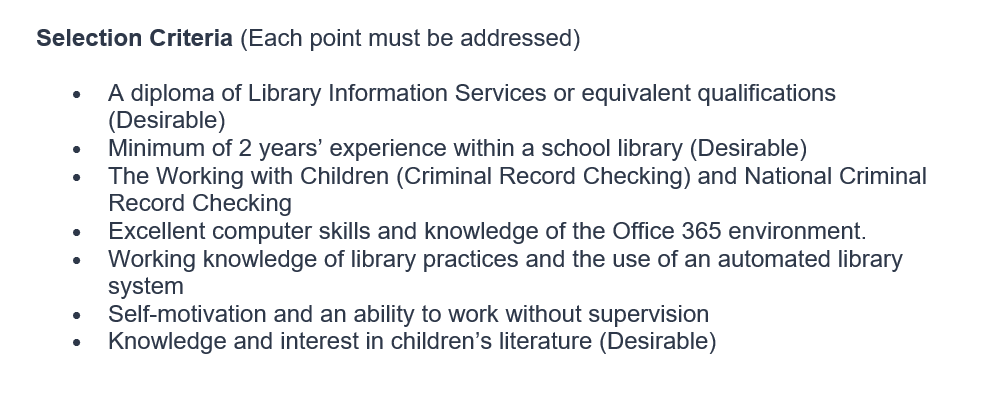
Let’s look at 10 things to keep in mind when addressing selection criteria in a cover letter.
1. Start Your Cover Letter in the Standard Cover Letter Format
Begin your cover letter in the standard format, with a header containing your contact information. Then, include the employer’s contact details, including their name (or a generic salutation like “Dear Hiring Manager”). Use a standard font and font size, like Arial 10-12.

2. (Opening Paragraph): Express Your Enthusiasm
Specifically state the role you are applying for. Convey your eagerness to contribute your skills and experience to the organisation. You might also like to mention the company’s values, and how your own align (tip: be specific and authentic here). If there is something else that attracts you to the organisation (such as a recent company achievement), you might like to mention it here, to show you have a good understanding of them.

3. (Body Paragraphs): List and Highlight Each Selection Criteria
List and highlight each of the selection criteria in the body of the cover letter. This will help you keep on task and ensure each selection criterion is adequately responded to (note: you should remove this at the end – see step 9).
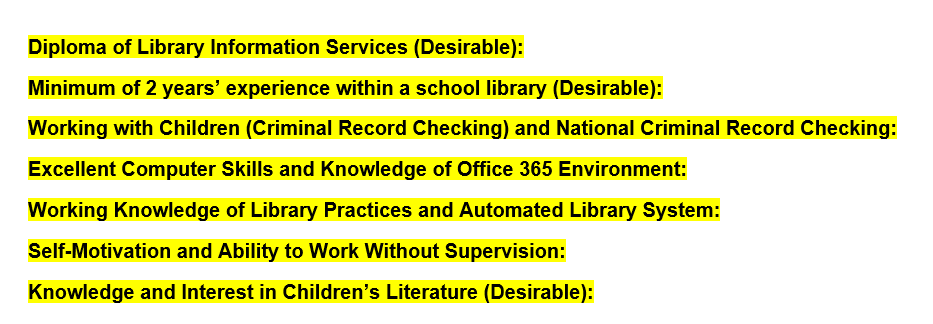
4. (Body Paragraphs): Paraphrase Each Criterion and Your Experience
Write an introductory sentence for each criterion, paraphrasing the language and keywords used in the selection criterion.

5. (Body Paragraphs): Brainstorm Ideas for Each Criterion
Make some notes within your document, then choose your ‘best ideas’. Tip: you’ll need to be as specific as possible. Rather than saying you communicated daily with different customers in a previous role, think of a specific time you communicated with a specific customer, and how you had a positive impact.
6. (Body Paragraphs): Use the STAR Format for Each Example
The STAR format is a well-known way to structure selection criteria. It goes like this:
Situation (S): Briefly set the context by describing the situation or problem you encountered. Keep it concise to provide necessary background information. This section should make up approximately 10% of your response.
Task (T): Describe your specific role or task within the situation. Explain what was expected of you and any challenges or goals you needed to address. This section should make up around 10% of your response.
Action (A): This section should make up around 60% of your response. Describe the actions you took in detail. This is where you showcase your skills, competencies, and problem-solving abilities. Use specific examples, highlight your contributions, and explain your thought process.
Result (R): Approximately 20% of your response. Conclude by outlining the positive outcome or result of your actions. Mention any benefits to the organisation. While this is one of the smaller sections, it is one of the most important. Many candidates forget to include a strong result section.
Note, the STAR method is not necessary for yes/no criteria such as certain qualifications. For these criteria, you can simply state that you have the required qualifications.

7. (Conclusion Paragraph): Sign-off Positively
Conclude your cover letter with a short paragraph thanking the reader for their time, and welcoming the opportunity for an interview. You may like to reiterate your interest in the role.

8. Sign Off as in a Standard Cover Letter
End with a professional sign-off such as ‘Kind regards’ or ‘Yours Sincerely’, along with your full name. There is no need to sign the cover letter.

9. Remove the Highlighted Selection Criteria
Since these headings were included only as a guide for you, you should now remove them. Your introductory sentence within each paragraph will be enough to allow the reader to understand that you have addressed each one.
10. Proof-Read and Submit
Proof-read your document for any errors, including grammar and spelling. You may like to have a friend or family member complete this part for you. Another tip is to save the document as a PDF, and read through it that way (the doucmnet will look slightly different and will allow you to assess it with fresh eyes).
Cover Letter Addressing Selection Criteria Example

Frequently Asked Questions
Can you address selection criteria in a cover letter.
There are a few different formats for responding to selection criteria. Sometimes, you may be asked to respond to specific online questions related to the criteria. Sometimes, you may be asked to provide a ‘separate document’ style selection criteria response. Sometimes, you can address selection criteria in a cover letter. It is important that you thoroughly read the application guidelines to determine what is required.
How long should a cover letter addressing selection criteria be?
A cover letter addressing selection criteria should typically be between one to two pages. If the application guidelines specify a length, you should always adhere to that.
How to address selection criteria you don’t meet?
Selection criteria are sometimes deemed either essential or desirable. You should provide a response to both essential and desirable criteria, even if you don’t meet them. You should provide a summary of your most transferrable skills and experience.
Our selection criteria writers specialise in addressing selection criteria, both in cover letter and other formats.
Contact us if you need more assistance with your application.
Read our latest resume tips .

Nicole Wren
Senior Writer
Nicole is the principal resume writer at Resumes to Impress. Nicole loves writing and sharing her knowledge about all things job hunting and career guidance.
Recommended Services:

Selection Criteria Writing
- Adelaide Resume Writers
- Resume Writers Bendigo
- Resume Writing Service Brisbane
- Resume Writing Services Cairns
- Resume Writing Services Canberra
- Resume Writers Darwin
- Resume Writers Diamond Creek
- Resume Writing Services Geelong
- Resume Writing Services Gold Coast
- Hobart Resume Writers
- Resume Writers Launceston
- Resume Writers Mackay
- Melbourne Resume Writers
- Resume Writing Services Newcastle
- Resume Writers Parramatta
- Resume Writers Perth
- Resume Writers Sunshine Coast
- Resume Writers Toowoomba
- Resume Writing Services Townsville
- Resume Writers Wollongong
- Interview Coach
- LinkedIn Profile Writer
- Resume Writing Services For Veterans
- Mining Resume Writing Services
- Nurse Resume Service
- Professional IT Resume Writing Services

- List of services
- Employment services
- Current vacancies
- Register for job alerts
- Become a temp
- Submit your CV
- Other services
- Payroll services
- International candidates
- Job hunting blog
- Recruitment services
- Permanent recruitment
- Executive search
- Temp recruitment
- SEEK advertising
- DISC profiling
- Outplacement
- Payroll outsourcing
- Contingency vs retained
- Recruitment blog
How to address key selection criteria in a cover letter
This article is recommended for individuals near the beginning of their careers, introduction.
Having spent a significant portion of my career in the realm of recruitment, I've come to understand the importance of job seekers ably addressing the key selection criteria of a vacancy in their cover letter.
It can truly make or break your job application. This is particularly true when an employer has noted these criteria as basics.
Allow me to share with you a step-by-step guide for taking on the key selection criteria within your cover letter.

How to address selection criteria
Understand the criteria.
As a start, read over each of the key selection criteria talked about in the job ad. Make sure you have a clear grasp of what the employer is looking for in a candidate.
Create a table or list
Sort the key selection criteria into a table or a list format. This will help you keep track of each criterion and your answer to it.
Use specific example
For each criterion, give specific examples from your past work experiences, education, or other related aspects of your background that show your skills, abilities, and experiences related to that criterion. Be sure to talk about your achievements, responsibilities, and any measurable results.
Follow the STAR method
When discussing each criterion, try using the STAR method (Situation, Task, Action, Result) to write your responses. Describe the situation or context, the task you had to carry out, the actions you took, and the results you gained. This is a clear and concise way to show your qualifications.
Highlight relevance
Make a strong link between your qualifications and the requirements of the job. Explain how your skills and experiences align with the specific criteria and how they will elevate your success in the role.
Tailor each response
Customise your answers for each criterion to match the language and terms used in the job ad. This shows your attention to detail and that you've carefully thought about the employer's needs.
While giving detailed examples is important, aim to keep your responses concise and focused. Avoid undue elaboration or extra details that could take away from the main points.
Prioritise & order
Cover the key selection criteria in the order of importance as shown in the job ad. If the criteria are not explicitly ranked, try addressing them in the order that best reveals your strengths and relevance to the role.
After drafting your responses, carefully edit your cover letter to ensure it is free of errors, typos, and grammatical mistakes. A well-written cover letter shows your professionalism and attention to detail.
Overall cover letter structure
Integrate your answers into the overall structure of your cover letter. Start with an introduction that briefly talks about the role you're applying for and why you're interested. Then address the key selection criteria, using a paragraph for each criterion. Finally, finish with a summary of your enthusiasm for the role and your availability for further discussion.
If you're looking for more in-depth help with cover letter writing, please click the button below to read my free e-book on the topic.
By following these steps, you'll be able to effectively discuss key selection criteria in your cover letter, making a great case for your suitability for the job.
Remember to customise each cover letter for the specific position you're applying to, as a tailored approach is more likely to capture the employer's attention.
For further assistance, I recommend you check out myfuture's article: How to respond to key selection criteria .

Are you looking for a job?
Now that you understand how to address key selection criteria in a cover letter, you should take a moment to check our current vacancies page .
At 11 Recruitment, we have a range of white-collar temp and perm jobs available. We're always on the lookout for top talent to place with our clients, so we encourage you to apply for any positions that are of interest.
If none of our current vacancies are right for you, you should register for job alerts . Then we’ll be able to notify you when we receive a position that matches your profile.

How to handle screening calls

How to determine career goals

Do I need a resume to apply for a job?

How to find a job in Perth

Do recruiters look at social media?

How to build a personal brand on LinkedIn

Is it good to include hobbies in a resume?

How to take a good profile picture for LinkedIn

How to write a job application email

What jobs are in demand in Australia?

How to determine what motivates you

What to say if you’re late for an interview

Examples of hobbies and interests in resume

Should you put referees on your CV?

How to write a great LinkedIn headline

How to build professional relationships

How to write availability on a resume

How to tell if your new job is going well

How to make conversation

How to upskill
Click here to learn more about 11 Recruitment

What are your thoughts?
I'd love to have a conversation with you about this topic - please leave a comment below if you have any thoughts or opinions 🙂
Christian Madsen
Managing Director of 11 Recruitment
How to add education to LinkedIn
What to expect in a second interview, how to be a good manager.
Session expired
Please log in again. The login page will open in a new tab. After logging in you can close it and return to this page.

Writing Your Key Selection Criteria Responses
Posted october 13, 2011, by sue stevens.
Many people applying for government jobs for the first time may not be aware of the importance of selection criteria responses, or how to approach them. These are a critical part of most government applications and essential to creating an outstanding application.
Even if you have a brilliant resume that shows you have excellent skills and qualifications to do the job and you’ve written an absolutely sensational cover letter tailored to the position , if you don’t address the selection criteria in a separate document that explains how well you fit each criterion, chances are you will be overlooked. Fulfilling the selection criteria to the satisfaction of the selection committee is the only way you can make it across the line to the next stage of the recruitment process – the interview.
Where to start?
The first thing you need to do is find out what the selection criteria are. You will find them either in the advertisement or on the government department’s website along with a downloadable job application kit.
Then you need to create a new document and list all the criteria, word for word, as they appear in the job application kit.
Name the document and make sure you include your own name at the top of the page. You can use a heading such as:
- Statement addressing selection criteria
- Selection criteria summary
- Responses to selection criteria
- Statement of claims, selection criteria
FYI When it comes to naming documents, all your application documentation should have your name prominently displayed and it’s best to name the electronic documents with your name, not just ‘selection_criteria.doc’. This will make it easy for the receiver to identify your document from all the others that have also been submitted.
Give examples
When answering the selection criteria think about how you meet each selection criterion and list examples of relevant skills, experience, incidents, training and personal qualities. You need to make the link between what you can do, and have done in the past, and how it relates to the job. If you don’t have any actual work experience, use other relevant experience such as something you have done at university, for a voluntary organisation or a club to illustrate your capacity to undertake the work required.
In every answer to the criteria, you need to demonstrate that you have developed and practised these skills in your past experience/s. It’s not enough to just state that you can do ‘it’.
Use keywords
Part of the trick of responding to selection criteria is identifying and understanding the keywords in each criterion and incorporating these into your response. These subtle differences and the way you word your response could be what sets you apart from the other applicants.
Know the difference between phrases such as ‘ability to’ (means having the skills), ‘knowledge of’ (familiarity gained from actual experience) and ‘understanding of’ (fully comprehend the matter). Incorporate your understanding of these terms into your response and you’re on the right track to submitting an outstanding statement.
Choose the right words
When writing a selection criterion response, find one excellent example from your past and demonstrate what and how you achieved a good outcome. Make sure that you use strong action words such as ‘demonstrated’, ‘reviewed’, ‘developed’, ‘initiated’ or ‘negotiated’ rather than less powerful words such as ‘involved in’ or ‘assisted’.
Always give examples and avoid unsubstantiated claims. You can use bullet points if there is a list of points you are making.
Address all the parts
More often than not, selection criteria will consist of several parts and are sometimes qualified as either essential (must-have skills and experience) or desirable (good to have and improve your chances of being highly regarded).
It is tempting to write a broad response focusing on just one part of the criterion and hope this will get you through. But if you want to hit the selection criteria nail on the head and guarantee yourself an interview, then this isn’t good enough.
For example, ‘Ability to contribute ideas and demonstrate initiative and flexibility’ actually has three components – ability to contribute ideas, demonstrate initiative and demonstrate flexibility. In order to respond to this correctly it is vital that you address all three of these skills, making sure to include the keywords in your response.
STAR approach
As mentioned above, the key to responding to selection criteria well is to address all parts of the criterion, to include the keywords and give specific examples. Many well-written statements follow what is known as the STAR method of response: Situation, Task, Action, Result.
The following example response is broken up into the STAR components, with each section labelled. This is for your benefit – don’t label the sections in your final statement!
Ability to apply academic knowledge and concepts to practical situations
Another acceptable way of answering selection criteria is SAO: Situation, Action, Outcome. Whether you choose STAR or SAO, it is important that you show how you can meet each criterion.
The final touches
Some government departments and agencies do not want any more than three paragraphs per criterion (or about 250 words); others do not have any limit. As a general rule, try to be as concise as possible and at the maximum, write no more than one A4 page per criterion.
Once you have completed your statement of claims in relation to selection criteria, check over your responses and make sure there are no typographical errors and that the sentences read well.
Finally, make sure that the formatting of your selection criteria document matches the accompanying resume (or CV), cover letter and any other documentation you are submitting. By having a consistent formatting style with fonts and font sizes, your application will present as a cohesive whole. This alone shows that you have taken considerable care and attention to detail.
Get the selection criteria right and you’re on your way to an interview – and one step closer to the job!
If you’re looking for inspiration, take a look at our sample key selection criteria responses .
Sue stevens.

Thanks for your enquiry
Good luck with your studies.
- Bookkeeping
- Financial Planning
- Animal Care
- Animal Science
- Dog Training
- Horse Breeding & Equine Studies
- Pet Grooming
- Veterinary Nursing
- Graphic Design
- Interior Design
- Photography
- User Experience Design
- Building & Construction
- Real Estate
- Business Administration
- Business Development
- Business Operations
- Change Management
- Customer Engagement
- Entrepreneurship
- Human Resources
- Leadership & Management
- Organisational Development
- Project Management
- Quality Management
- Small Business
- Supply Chain Operations
- Alcohol & Other Drugs
- Community Services
- Individual Support
- Education Support
- Training & Assessment
- Engineering
- Manufacturing
- Agriculture
- Conservation & Land Management
- Health Science
- Horticulture
- Sustainability
- Eyebrow Specialist
- Eyelash Extension
- Hairdressing
- Nail Technology
- Allied Health
- Counselling
- Dental Assisting
- Health Services Assistance
- Life Coaching
- Medical Administration
- Mental Health
- Natural Therapies
- Naturopathy
- Practice Management
- Sports & Fitness
- Event Management
- Hospitality
- Wedding Planning
- Cloud Computing
- Cyber Security
- Data Science & Analytics
- Programming
- Systems Administration
- Web Development
- Compliance & Risk
- Criminal Justice & Psychology
- Work Health & Safety
- Digital Marketing
- Digital Media
- Social Media Marketing
- New South Wales
- Northern Territory
- Western Australia
- South Australia
- Graduate Diploma
- Advanced Diploma
- Graduate Certificate
- Certificate
- Certificate II
- Certificate III
- Certificate IV
- Courses by Provider
- Government Funded Courses
- Student Hub
- The Workforce Training Hub
Selection Criteria Examples: 13+ Good Selection Criteria Responses
In this post, what are selection criteria, how to address selection criteria, the star model in selection criteria, what are the different types of selection criteria, selection criteria examples and templates, selection criteria faqs.
In this post Show
Selection criteria have the power to decide the fate of your job application. Imagine: you’ve been on the edge of your seat for two weeks, waiting to hear back from your dream employer . And now — unbeknownst to you — the moment of truth has arrived.
With a double click, Gary the hiring manager brings your application up onscreen. He rubs his eyes, takes a gulp of coffee and a deep breath, and starts skimming through your resume and cover letter .
If you’re applying for a position where the job advertisement included selection criteria (for example, a job in the Australian Public Service , or a large company), things can go one of two ways from this point:
“Wow, this applicant’s experience could make them a great fit,” Gary thinks. “And their cover letter tells me they’re passionate about this field.”
He glances across at the list of key selection criteria for this position. And then he realises there’s no third page. You haven’t addressed the selection criteria at all.
He closes the window, sighs, and drags your application to the bin. Next!
Gary reads your stellar resume and your eloquent cover letter. Then he opens your ‘Key Selection Criteria Responses.docx’ document.
He compares your selection criteria responses against his list. A smile starts to spread across his face, and he sits up a little straighter. You’ve used the right keywords, structured it with the STAR framework, and organised it into skimmable bullet points. Gary adds your application to the shortlist — the selection panel is going to love it.
Okay, so Gary isn’t real, but key selection criteria are very real. Take them seriously, or be ready for Scenario A (i.e. the bin).
But don’t worry — you already have the skills you need to do an excellent job. If you’ve ever told a story to a friend about something that happened at work, you’re halfway there.
Today, you’ll get the tools you need to get the rest of the way — all the way into your dream job.
Selection criteria are the essential skills , knowledge, experience and qualifications you must demonstrate to be eligible for a job. HR departments use them to evaluate candidates’ competency, and they are necessary for most government jobs, and for new roles at most large organisations. They don’t just benefit hiring managers, either. You can use them to see whether the job is a good fit for you.
It’s crucial to answer the selection criteria when applying for a position. To respond to key selection criteria, create a separate document to your covering letter and resume — both of which you have customised for this position, using the same language as in the job description. You’ll need to describe how well you meet each of the primary selection criteria in order to answer them, provide detailed information when asked, and use relevant examples from your work experience.
Job advertisements may also list desirable criteria . Unlike the key selection criteria , these aren’t essential. But if you can show that you possess these criteria too, your chances of scoring a job interview will be much higher.
What are some examples of selection criteria ?
- Ability to work in a team and a collaborative environment
- Exceptional time management skills and ability to meet deadlines
- Ability to demonstrate a high level of effective team management
- A qualification in a relevant industry area
- What skills do you have that are relevant to this position?
- Is it possible for your abilities to be transferred to this position?
- How do you go about honing your skills?
- Give some examples of your abilities in action.
- What relevant professional knowledge do you have for this position?
- What skills would you bring to this position?
- How do you keep your knowledge and skills up to date?
- What kind of experience did you get and where did you get it?
- What is your level of experience?
- What skills do you have that might be useful in this position?
- Give a few examples of how you’ve used your skills.
- What qualifications do you have that would make you a good fit for this position?
- What personal qualities do you have that would make you a good fit for this position?
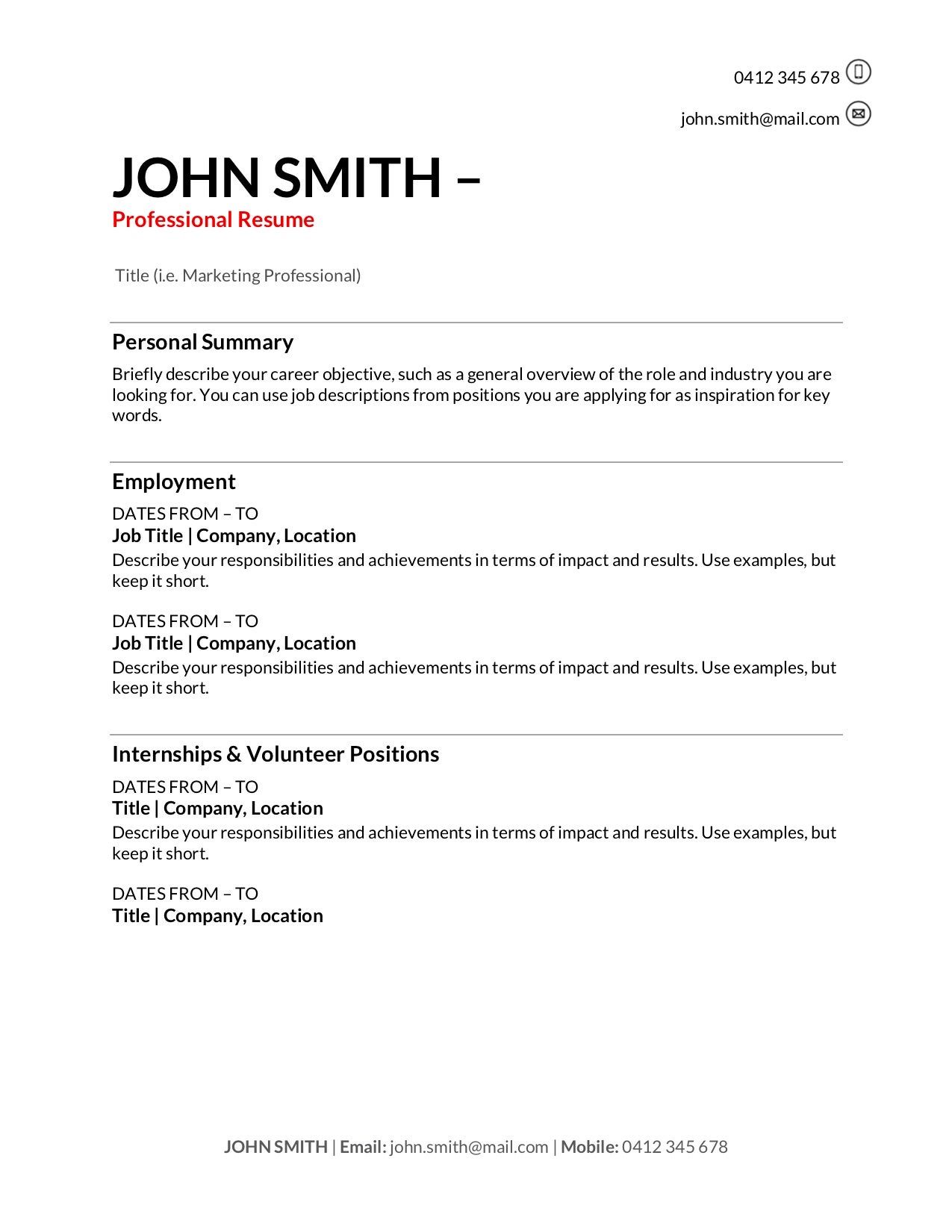
Need resume templates?
Get your job application started with templates to create a polished, professional resume, tailored for Australia.
When addressing selection criteria as a job applicant, you must be thorough. To do this, you must explore each criterion mentioned in the advertised position description in separate paragraphs and relevant examples. Back up your answers with related examples of what you have achieved and why these experiences will help you thrive in the role.
Here are five simple steps to effectively answer selection criteria:
- Analyse and dissect the selection criteria
- Write an opening statement
- Brainstorm ideas for each selection criterion
- Go into further detail and support your claims with ‘the how’
- Write out in full sentences, using a checklist
Read on for more detail.
1. Analyse and dissect the selection criteria
Read the selection criteria on the job advertisement thoroughly before jumping right in. As an example, let’s look at interpersonal skills. The associated criterion details could be ‘ w ell developed interpersonal skills’ .
This includes the ability to:
- Express opinions, information and critical points clearly and concisely via effective verbal communication
- Effectively working with others to resolve interpersonal conflicts in a positive way
- Being able to work in both formal and informal settings with others in groups and teams
If you look into this further, you can break down the desired sub-skills:
- Verbal communication
- Problem-solving and decision-making skills
- Team-working
2. Create an opening statement
For each selection criterion, clearly state how you fulfil it in one sentence making sure you incorporate key points. Keep it short – you will go into further details and specific examples and relevant experience in the next step.
“I possess strong interpersonal skills, which I have developed throughout my role as a Project Manager.”
3. Brainstorm ideas for each selection criterion
Here, you can pull together some examples of your work experiences relevant to the role you are pursuing. For example, sticking with the theme of Project Management, an applicant may think of the following scenarios to show how they fulfil the selection criteria before writing their response:
- Project Manager at X – Encountered conflicts when managing teams and resolved these accordingly.
- Project Manager at Y – First managerial role. Perfected verbal communication through many encounters with fellow team members. Learned to deliver my points clearly and concisely.
- Project Coordinator at Z – Working with teams.
4. Go into further detail and support your claims with ‘the how’
Once you’ve got the base points that surround the overarching selection criteria, you can then go to these and choose which examples suit best. A great way to do this is by employing the STAR Method technique.
Example response to the STAR Method:
5. Write out your responses in full sentences, using a checklist
Now, you can write the paragraph in full. When reading through your final draft, check the following steps before you submit your job application.
Have I addressed all elements of the selection criteria?
Once you’ve completed your application, it is good to revisit the wording of that particular selection criterion found in the position description. Make sure your content correlates and that the descriptors used in the advertisement are directly addressed in your writing. Double-check that you have met the requirements of the process itself- there may be a word limit you need to stick to, or the recruiter might ask you to list examples using bullet points instead of keeping them in paragraph format.
Are my claims justified with relevant examples?
This is as simple as making sure you are specific, concise and that your answers remain relevant using real experience. There is no use going on a tangent and writing an essay if it is a bunch of useless content irrelevant to the position.
Have I chosen the right words?
Match your language with that used in the job advertisement. When a recruiter is scanning your document, and there are words that they believe to be relevant to the position, this will more than likely generate some interest – after all, every corporate job posting gets 250 applications on average. Hence, yours needs to stand out in the selection process to make it on the shortlist.
Avoid ambiguous and passive language to make sure your writing is clear and delivers your point effectively.
Has someone else proofread my response?
Sometimes a new set of eyes can pick up on some mistakes that you might have missed. When you’ve been working on a piece for a long time, everything starts to look the same. Have them look through your work and compare it to the job advertisement – they may be able to offer some insight on how to improve your piece further.
The STAR model is one technique used to demonstrate relevant information for a specific capability within selection criteria.
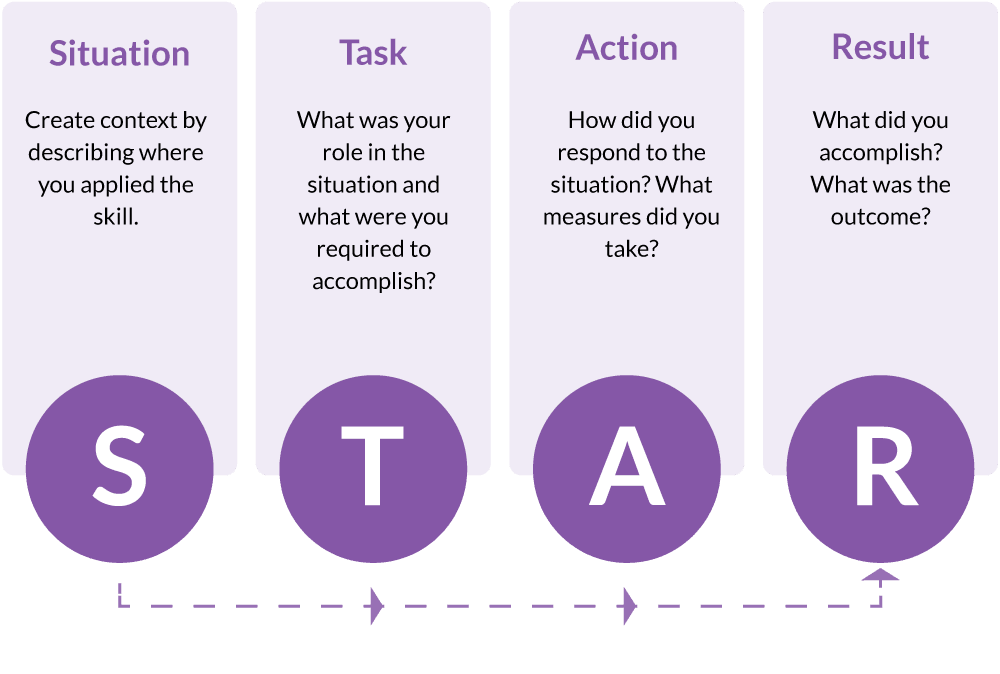
Create context by describing where you applied the skills that helped to gain your knowledge
What was your role in the situation, and what were you required to accomplish?
How did you respond to the situation? What measures did you take?
What did you accomplish? How does this result relate to the job that you are applying for?
Selection criteria are more than just the desired skills an employer is looking for. It also includes experience, abilities, awareness and both hard and soft skills. The most common type of selection criteria includes qualifications. Most jobs, especially at a professional level, have a set requirement of qualifications needed.
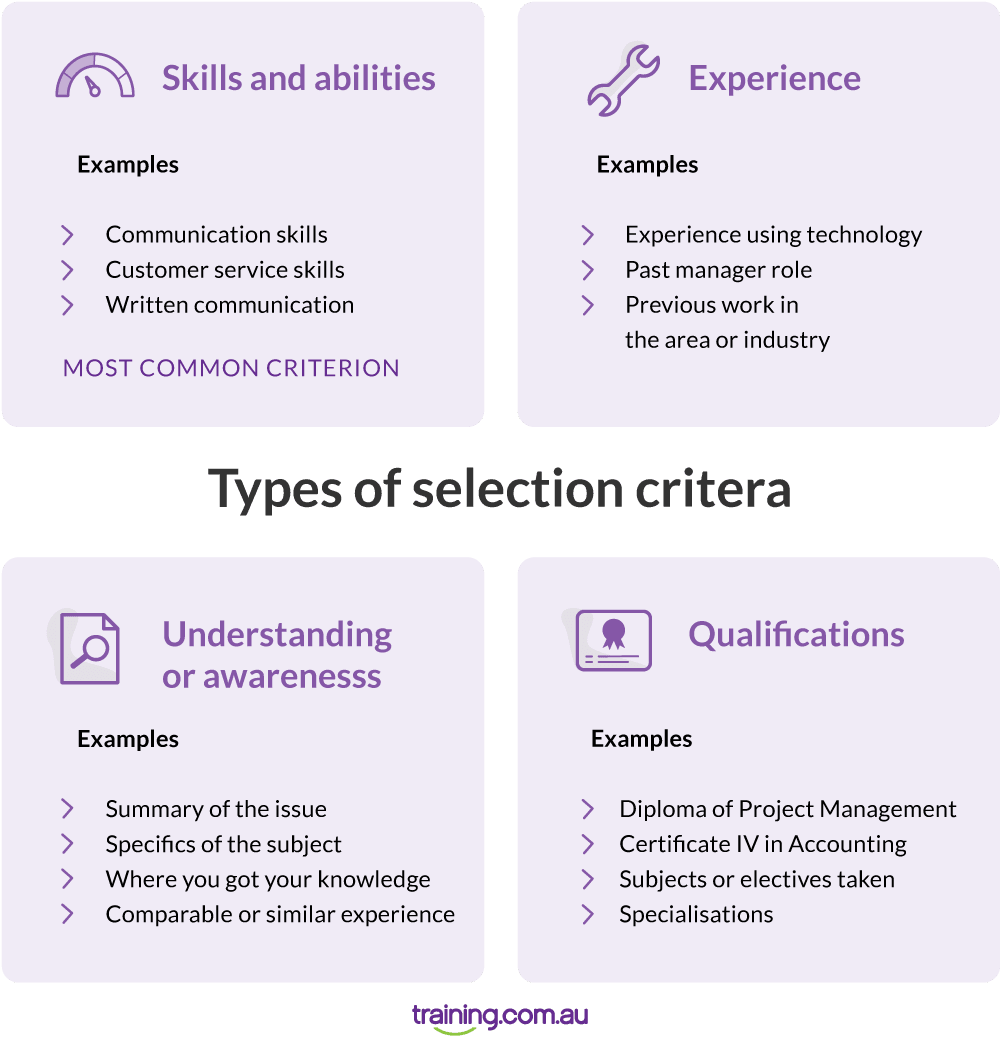
Course Finder Questionnaire
Step 1 of 5
What is your motivation to study?
If you want to understand more about what it takes to write a successful selection criteria response, find some of the most popular criteria skills below and our examples of them. Whether you need to show your communication, teamwork, or technology abilities, use these examples to write your perfect response based on your experience.
Selection criteria: Proven ability to work in a team and a collaborative work environment
Here is an example of a typical teamwork selection criteria . The readers are looking for an example of when you’ve worked in a team as proof that you’ll be able to share and work with other employees if they hire you.
Teamwork criteria example
When working in hospitality, I continually proved my ability to work with a team in a very team-oriented environment. While at Johnny’s restaurant, I worked in a large team every shift, and in hospitality, teamwork is crucial to providing smooth and efficient service. Daily tasks were often team-oriented, including service, preparation and post-service jobs, which needed to be coordinated amongst staff to ensure we completed everything.
This coordination meant communicating with other staff on shift, including chefs, dish staff, bar staff and other floor staff, and regularly attending meetings where I collaborated with other employees and management to improve the way we delivered service to customers. Regardless of how new an employee was or what training level, I treated every other staff member as equals, which helped forge professional associations and strengthened the team overall. As a result of my teamwork skills and collaborative work efforts, management often offered me extra shifts because they knew that I could work effectively with everyone to get the job done.
Selection criteria: Demonstrate a high level of effective team management
Here is a popular way of wording selection criteria for leadership skills. When a potential employer asks this, you may either be looking at a job that requires or may require leadership in the future or a position where you may have to be semi-autonomous.
Team management criteria example
When working at Smith and Son’s as a receptionist, I often had to demonstrate an ability to lead teams. After working there for five years, I became one of the longest-serving receptionists, which meant leading team meetings, organising staff events and coordinating a team of up to five receptionists at a time working on the floor. Growing genuine friendships and connections with new staff members was a priority to complete these tasks, as I knew they would come to me with problems more readily. I also needed to visibly complete my daily tasks ahead of schedule so that other receptionists would respect my participative leadership style. Staff will not respect a leader if they can’t do their job. As a result of my collaborative and friendly leadership, staff were confident in my ability to lead them and often came to me to communicate with upper management on their behalf, as well management relying on me to collaborate with them regarding receptionist staff and their needs.
Selection criteria: The ability to show a high level of quality customer service and management
Here is a typical example of phrasing for customer service selection criteria . This criterion means that the job you’re applying for will have customer-facing tasks, and management is looking to see that you have experience working with customers.
Customer service criteria example
While completing my studies, I worked part-time at Myer as a sales assistant for two years, where customer service was one of the most critical elements of my job. During my time at Myer, I worked across several departments. I demonstrated my customer service skills multiple times, especially with tricky customers or clients upset about something outside my control.
Clear communication and genuine concern with a customer’s needs is crucial to delivering exceptional customer service. When I worked in the womenswear department, a mother of the bride came in whose outfit had arrived (they’d ordered the dress online), but it didn’t fit, and we weren’t able to get a replacement in time for the wedding.
The customer was understandably distraught, so I worked with her over a few hours, calming her down and coming up with some options for alternatives. This process included calling down items from different departments and ensuring she felt important and valued by getting her to sit down and have a cup of tea while I found all the pieces she wanted to view — or that I thought she might like.
She ended up finding a dress that she liked more than the original and left a positive review a few days later on our Facebook page about her experience. Being able to help people when something goes wrong is one of the most rewarding elements of customer service and management. I developed this skill while working at Myer, as evidenced by many positive reviews and winning ‘best sales assistant of the month’ five times over my two years.
Selection criteria: Demonstrate the ability to use business technologies and analyse data and information effectively
Here is an example of how using technology selection criteria may be worded in a job application. In this case, the reader is looking to see how you’ve used relevant business technologies in the past and that you’ve been able to read the information given by these programs accurately.
Technology criteria example
When completing my Diploma in Administration, I was required to complete work placements that used business technologies in everyday tasks, including online library databases, microfiche and Microsoft office, and basics in Xero software.
When I completed my month-long work placement at Smith’s Chiropractors, I discovered that they were still using entirely paper-based data collection systems. I organised the transfer to a cloud-based company database system. This process included uploading files to the cloud, then connecting with multiple other programs, including Microsoft Excel, to create spreadsheets for chiropractors at the office to use in their day-to-day work. It also meant analysing large quantities of data online and turning them into practical, easy to use information.
This use of business technologies helped both the chiropractors and the full-time administration staff become more efficient. They were no longer reliant on a paper-based system. They streamlined several processes throughout the workplace, allowing the clinic to see where processes were going wrong or could be improved.
Selection criteria: Demonstrate the ability to apply analytical and research skills
Here is a common way job applications may ask you to prove you fulfil analytical and research selection criteria. They are looking to see that you can apply what you’ve learned in analytical skills and research to everyday situations.
Analytical and research criteria example
When I was training as a teacher’s aide, I researched the special needs school and students I would be working with, both in work placements and my future work. I researched autism and students on the spectrum, looking at how different students may respond to stimuli within the school environment or having another teacher’s aid to their usual one. Students with special needs often react in unusual ways to new and changing circumstances, so it was important that the research papers I was working on were relevant and gave me valid analytical accounts and theories.
The research I did, both within teachers aid training and independently, had to be applied in day to day practical ways, rather than just understanding the theory. I completed several projects on the topic, which required extensive literary research and analysing statistical data.
When I did my two-month-long work placement at St John’s primary school, I regularly applied the theories and concepts I had come across in my research in everyday situations. There was one student who particularly struggled with writing due to the texture of the pencils and pens. My investigation into textural sensations for students with autism helped me find ways to alter the pencils with everyday items, such as blue tac, which made it much easier for him to write. By applying the research to practical everyday learning, I helped increase class participation — not just for this student but also for students in other classes. This potential to improve learning outcomes is one of the most rewarding aspects of being a teacher’s aide.
Selection criteria: Proven ability to use interpersonal skills in everyday workplace situations
Here is a common way of phrasing interpersonal skills selection criteria. Interpersonal skills refer to, basically, people skills. Communication skills are a part of it because if you can’t communicate effectively, you’re not going to be much of a people person — but generally, they are separate.

Interpersonal skills criteria example
When working as a bartender at the Northern Hotel, there were many times when my interpersonal skills were called upon to improve difficult situations. In a busy hotel on a Saturday night, especially when customers have had a few too many drinks, relating to customers and talking them down from becoming angry is a crucial skill that I honed over the four years I worked there.
One night, a particularly irate customer was getting angry at one of our newest staff members who had cut him off. I didn’t want to get involved too early because this can often make new staff members feel undervalued, but I stepped in when he started getting personally offensive. The customer was a regular I knew relatively well, so I explained that I would have done the same thing and helped cool him down. I ensured that the new staff member was still involved, checked up on her several times throughout the night, and gave security and management a heads up.
Two years later, she told me that one of the reasons she had stayed working with us for so long was because she knew, from that first shift, that other staff members would always support her on shift. Management recognised my interpersonal skills formally, and I won the ‘most supportive staff member’ award at our annual awards nights organised by management.
Selection criteria: Job applicant must be competent with a high level of administration skills such as database management, Microsoft Office and basic computing
Employers are looking for individuals skilled in specific programs that ensure efficiency and modernisation. In the 21st century, organisations expect anyone with a level of administrative background or skills to be competent with multiple programs and the general handling of a computer system.
Administration skills and database management criteria example
Whilst completing my Diploma in Administration, I was fortunate enough to take an Internship at Elixir Wealth Advisory, where I was an assistant to the Administration Officer. The opportunity allowed my database and computing skills to improve significantly, whereby I became efficient in using multiple Microsoft and Google applications. Working in administration involved working with clients’ details, answering phone enquiries and ensuring I organised notices and meetings for all staff members.
One of the memorable days during my internship involved a client urgently requesting an appointment with his advisor. As the Administrative Officer was away sick that day, it was my job to fit the client into the busy schedule of the small business. I used our database system MySQL to rearrange the specific advisors day, then telephoned and used Microsoft Office to email other clients to inform them of their short-notice change to the day. Despite being short notice, the day’s meetings ran smoothly, and we could fit in the urgent session. Without using the databases and applications, the Advisory wouldn’t have known who the client was before they met and would not have been prepared to act quickly.
Selection criteria: Job applicant must have the ability to demonstrate sound written and oral communications skills
In many jobs, you need to show how you can effectively communicate as part of a team and to various people. Strong written and oral communication skills are vital in all departments and come in useful for daily tasks.
Written and oral/verbal communication criteria example
In my first full-time job at Flight Centre, oral and written communication skills were essential to being a successful travel agent. Many clients depended on me to tailor travel itineraries to their preferences during this career.
To ensure clients were satisfied both before and during their travel, communication was crucial to inform them of alterations to their plans. Once clients start their journeys, sometimes unexpected changes occur. One such situation was a significant weather disruption. A family of 4 were unable to travel to New York and spend the desired four days there. Due to their stopover in LA, I needed to organise four days of activities elsewhere. I made multiple phone calls to the clients to brief them on planning and status, understand their requests for the four days, and comfort them during this stressful time. Organising accommodation and activities in a different time zone required me to send many emails confirming availability on short notice. After constant communication with the family and many managers, I successfully reorganised the days spent in LA instead of New York, where the family enjoyed their altered stay. They even brought back a thank you gift for my consistent communication and quick thinking. Without being confident in my communication skills, being a travel agent would have been extremely difficult. It was crucial to organise, control, reach out to multiple people, and ensure clients were always satisfied with my service.
Selection criteria: Have the ability to prioritise tasks accordingly and demonstrate a high level of organisation
Organisational skills are a vital capability for working in any job in any field of work. The reader would be looking for an example of when you demonstrated your organisational skills at a time of need — or in your everyday work — that you can continue to display if they hire you.
Organisation criteria example
In my current position as the Year 6 teacher at Saint Mary’s Primary School, my job is to help the students become more mature before they reach high school and ensure their numeracy and literacy skills are all up to the standard. It is essential to teach them skills that will carry on throughout their schooling careers, such as organisation, socialisation and dedication.
One of my tasks as a teacher includes converting weekly objectives into achievable tasks that the students will understand, such as homework or in-class activities. For example, a typical Friday will mean the collection of homework. I analyse the homework and monitor which areas the students struggled, passed or excelled in and use this to integrate into the following week’s lessons. I will develop the week’s timetable appropriately, considering any activities the students have to attend, allowing me to determine the relative importance of each task.
By Monday morning, I am aware of the students’ weekly progress and tasks and have set the week’s goals. It is imperative as a teacher to remain constantly organised and prioritise the student’s needs and difficulties to ensure they can get the best education.
Selection criteria: Demonstrated time management skills with delegated tasks and ability to meet deadlines
Time management means that you need to demonstrate how you can work effectively. Employers expect all staff to make optimal use of their time and allocate it appropriately. Managing time is a crucial aspect of a business, and an employer needs to know how to use your skills to benefit the company.
Time management criteria example
While studying Business as a full-time university student, being part of a competitive dance team and having a part-time job at Kmart, my early 20’s were very busy. In addition to plenty of daily activities, I kept up with housework, grocery shopping and cooking, and proactively managed my full study load.
Whilst I considered myself a busy person, one week seemed particularly busy where I knew I had to manage my time well. That week consisted of two university assignments to complete, a total of 4 shifts at Kmart, and an extra dancing practice as there was a competition that weekend. I had to organise the appropriate time to allocate to each activity, as my Kmart shifts, university lectures and dancing classes were all at set times. To remain organised, I designed a timetable for the week, allocating my set activities first, and filling the blanks with when I could cook, study, sleep and attend to other activities. As one of the two assignments was due on the Friday of that week, I prioritised that task to complete first before I did the other one, which was due the following week. By Saturday, I had managed my time successfully as I met all my set commitments and had finished the first assignment Wednesday, leaving ample time to complete the second assignment during the rest of the week. It was continuously crucial in my 20s to manage my time appropriately in my day-to-day life and prioritise tasks based on their importance.
Selection criteria: Ability to approach difficult tasks and sudden changes appropriately
Employers are looking for an individual who can develop ideas to assist in formulating, creating and evaluating several possible solutions to a problem. Problem-solving skills are vital in high-stress scenarios and demonstrate quick thinking and versatility in the workplace.
Problem-solving criteria example
When working as the Head Waiter at Ballara Receptions, it was common for me to take control of multiple situations and lead the other waitresses by example and as a leader. The position itself entailed allocating specific tasks to the waiters and ensuring a smooth flow of the night. One night, there was an error in the number of guests attending the wedding. Whilst this issue needed to be dealt with quickly, there was not enough staff to meet the number requirements. I had to re-organise my plan for the night and allocate extra tasks to the other waiters to make up for the lack of staff and the additional people. There were many situations to rearrange, such as seating, the number of staff allocated to each job and the extra materials needed to serve the guests.
Whilst it was lucky a staff member was willing to work that night, without the ability to adapt quickly and evaluate a situation, the night would not have gone smoothly with the multiple changes that occurred.
Selection criteria: Strong analytical skills and attention to detail
Analytical skills are essential in the workplace as they tie in with problem-solving. An employer wants to understand how you gather information, analyse it, and solve problems that ensure a smooth workplace productivity flow.
Analytical skills criteria example
It is essential in any job to constantly evaluate simple and complex problems in the workplace using skills such as paying attention to detail and researching and analysing problems.
When I was completing my Certificate IV in Bookkeeping, I was required to undertake a group assignment that required us to record an actual business’s financial affairs for a month. We worked with Benjamin’s Patisserie to help ensure his sales and costs were accurate. Whilst spending time at the café and working closely with the staff, I noticed that all staff completed multiple jobs throughout their shift with no allocated task for each. It became noticeable that some team members were more suited to a specific task such as serving, making coffee and working the cash register. I suggested to the owner Benjamin that he allocate tasks to each staff member based on their strengths and weaknesses. Immediately I noticed that sales increased as there was a smoother flow of productivity in the café, tasks were completed efficiently and at a higher standard than before. It is crucial always to analyse ways an organisation can improve or if there is an issue that you can resolve as it helps to increase success in the workplace.
What is the difference between selection criteria and selection process?
Selection criteria play a role in the selection process, and are used as a tool to choose the most suitable applicants for a position.
The selection process is the procedure an organisation uses to hire new people. Usually, the company will form a selection panel of two to three staff who will review all applications, then choose a group of applicants to advance to the interview stage. This process can include an interview, a written assessment, and psychometric testing. In most cases, this takes 4 to 8 weeks.
How do you write a good selection criteria?
To write a good selection criteria response, use the specific language from the job description, use concrete examples that prove you meet the criteria, and provide measurable outcomes where possible.
What is the difference between selection criteria and job qualifications?
Qualifications are a type of selection criteria, and are used in some jobs to ensure that a new hire has the appropriate certification to work in this role, as required by the industry.
How long should a selection criteria response be?
Generally, a selection criteria response should be around 250 words. This will vary depending on the question asked, however. For example, some criteria may only require you to state your qualifications. On the other hand, some may ask you to give a more detailed description of a scenario.
What kind of examples can you use in your selection criteria?
It’s usually best to use examples of times when you had to deal with an unusual or unexpected situation at work, but you can also use more general examples that show how you managed your day-to-day tasks.
What are some reasons for rejecting a response to selection criteria?
Hiring managers may reject an applicant who:
- Fails to proofread their selection criteria responses
- Fails to use concrete examples
- Uses irrelevant examples

Perfected your selection criteria responses?
… then you’re ready to polish your interview technique. Your interviewer is bound to ask some of these 38 interview questions — are you prepared for them?
Download PDF
- Firstname *
- Industry * What industry are you in? Administration Agriculture & Horticulture Arts Beauty Buiding & Construction Business & Accounting Child Care Design Education Fitness & Personal Training Government & Defence Health & Nutrition Hospitality Human Resources (HR) Information Technology (IT) Insurance Legal Logistics Marketing Mining Music, Film & Television Project Management Psychology Real Estate Retail Travel Work Health & Safety (HMS)
- Comments This field is for validation purposes and should be left unchanged.
Thanks for downloading the template
- Popular Subjects
- Qualification Type
- Courses by Location
- Business Admin
- Courses In ACT
- Courses In NSW
- Courses In NT
- Courses In QLD
- Courses In Tasmania
- Courses In VIC
- Courses In WA
Newsletter sign up
Newsletter sign up.
We’ll email you updates on job trends, career advice, study tips, news and more.
You are currently visiting our Australian website Training.com.au
Would you like to visit our New Zealand website instead?
Move forward, get ahead.™
- Jan 24, 2021
How To Write A Cover Letter That Addresses The Selection Criteria
#selectioncriteria
#addressingcriteria
#coverletter
Do you need to address a set of key selection criteria within your cover letter, but don't know where to start? In the following post, I will explain how to appropriately incorporate your responses to the key selection within your cover letter .
Make sure that your cover letter has an introduction and a conclusion.
Write up the cover letter as you normally would for any other job. Generally speaking, most cover letters are just a page long. However, because you need to address selection criteria within your cover letter, likely it will go over to two or more pages.
So, with any cover letter, make sure that your letter has all the primary details (address, employer name, your name, date, etc.) plus an introduction and a conclusion.
List out the selection criteria and respond underneath each point.
Nicely structure your letter addressing the selection criteria with headings for each criterion.
After you've done that, you can then write responses for each point listed.
- Key Selection Criteria Writing
- EXPLORE Random Article
How to Address Selection Criteria
Last Updated: October 11, 2022 References
This article was co-authored by wikiHow Staff . Our trained team of editors and researchers validate articles for accuracy and comprehensiveness. wikiHow's Content Management Team carefully monitors the work from our editorial staff to ensure that each article is backed by trusted research and meets our high quality standards. There are 9 references cited in this article, which can be found at the bottom of the page.
If you’re searching for jobs, you’ll notice that many job listings have what are called “selection criteria”: a series of skills and abilities that you should have in order to meet the job’s requirements. When you’re writing a cover letter to apply for a job, you’ll need to address each of these criteria specifically. Doing so will not only show the hiring manager that you’re a good fit for the job, but it will demonstrate that you are well-suited to fulfill the specific job requirements that the selection criteria ask for.
Analyzing Selection Criteria

- For example, an explicit selection criteria may read: “Applicants should be able to write clearly and expressively.”
- A more implicit criteria may say something like, “Writing skills are important in this position, and we’d like our ideal applicant to be able to express themselves clearly and succinctly.”

- For example, if the company wants applicants with “knowledge of” social media, they’re only asking for a demonstration of your knowledge, not hands-on experience.
- But, if they request “experience using” social media, you’ll need to provide anecdotal descriptions of your professional social-media usage, not just your intellectual understanding.

- If, for example, their website makes a big deal out of celebrating employees who are “team players,” you’ll know that the company is looking for employees who work well with others and don’t mind serving on group projects and committees.
Structuring Each Response

- Read the job ad closely. Some jobs may ask that you discuss the selection criteria in your cover letter and do not include a separate criteria-focused document. Or, they may want you to address the selection criteria briefly in your cover letter and in more detail in a separate file.

- Keep in mind that the paragraphs can be brief; they don’t need to exceed 8-10 sentences. It’s better to be concise and to the point than to seem long-winded.

- For example, you could write something like, “Over the course of my 10 years of work experience, I have developed strong written communication skills.”
- Or, say the selection criteria asks for a good “team player.” You could write, “I possess strong interpersonal communication skills and have managed over 40 projects during my career.”
Developing Your Responses

- For example, if the job ad states that they’re looking for someone with experience managing social-media accounts, you could mention how you successfully ran Twitter, Instagram, and Facebook for a large car dealership.
- As a general rule, all of the professional experiences and anecdotes that you describe should come from the last 2–3 years.

- For example, say you used to work at a large marketing firm, and drafted copy for a number of high-profile ads. You could write something like, “In my position at ABC Co., I wrote copy for a dozen ads that were featured in nation-wide periodicals. As a result of my copy writing, sales increased by 10% over a 3-month window.

- C: Context. Mention the context in which your actions took place
- A: Action. Describe the specific action you took (e.g., writing copy, initiating a new committee, or engaging in customer service)
- R: Results. Lay out the results of your actions and how it benefitted customers or your company.

- Say something like, “My years of high-level copy-writing experience and noted professional successes will enable me to train junior copywriters and provide polished, engaging copy in this position.”

- If they say “no,” ask them what changes they’d recommend you make to make yourself seem like a better fit for the criteria.
Expert Q&A
- Always use active verbs when you’re describing yourself in the workplace. Instead of saying, “I was responsible for team management,” write, “I managed and oversaw teams.” [12] X Research source Thanks Helpful 0 Not Helpful 0
- The term “selection criteria” is most commonly used by Australian and New Zealand businesses. If you’re job hunting in another part of the world, job ads may not use that exact phrase. But, it’s still valuable to know how to use your professional experiences to show ways that you’re a good fit for the job. Thanks Helpful 0 Not Helpful 0
- Some job ads will break out “high-priority” selection criteria and “low-priority” criteria. While you should still write a full paragraph for each criteria, spend more time and effort on the high-priority ones. Thanks Helpful 0 Not Helpful 0
You Might Also Like

- ↑ https://www.monash.edu/career-connect/build/job-workshops/selection-criteria#tabs__1713523
- ↑ https://www.katieroberts.com.au/career-advice-blog/how-to-nail-your-selection-criteria-responses/
- ↑ https://www.jobjumpstart.gov.au/article/how-address-selection-criteria
- ↑ https://sydney.edu.au/careers/students/applying-for-jobs/addressing-selection-criteria.html
- ↑ https://careers.vic.gov.au/how-to-reply-to-selection-criteria
- ↑ http://www.bom.gov.au/careers/guide2SC.shtml
- ↑ http://www.jobs.uwa.edu.au/applying/written/addressing
- ↑ https://about.unimelb.edu.au/careers/selection-criteria
- ↑ https://www.seek.com.au/career-advice/how-to-address-key-selection-criteria
About this article

Did this article help you?

- About wikiHow
- Terms of Use
- Privacy Policy
- Do Not Sell or Share My Info
- Not Selling Info
How to address selection criteria

What are selection criteria?
Selection criteria are the list of the skills, attributes and experience that an employer wants for a specific role. Employers use this information to assess an applicant’s suitability for the job.
Selection criteria can include technical skills (such as previous experience working in the role or specific qualifications or certifications) and personal traits (for example, customer oriented, attention to detail, team player).
The selection criteria for a role are often outlined in the job advertisement. They are usually linked to the employer’s ‘ key words’ . If you are approaching a business directly, you should research the employer (visit their website and social media) to get an understanding of what traits and skills they value in workers.
Formal versus informal selection criteria
Some larger organisations, including Government agencies, ask you to respond to specific formal selection criteria. The employer will usually indicate a word or page limit for each response. You should submit your responses to formal selection criteria as a separate document to the rest of your application.
Some examples of specific selection criteria are:
- demonstrated capacity to communicate effectively
- good organisational and administrative skills
- proven ability to work as part of a team
- well-developed customer service skills
For selection criteria that don’t require a formal response (for example, those outlined in a job ad) your cover letter is a good place to address any criteria.
When responding to selection criteria you need to make the link between what you can do, and have done in the past, and how it relates to the job. List examples of relevant skills, experience and personal qualities that you can use to provide this information.
If you don’t have any actual work experience, use examples from other activities such as school, voluntary work or other extracurricular activities, like sport.
Hints and tips
- Keep your response clear and succinct . Keep your cover letter to about a page in length. For formal selection criteria, always stick to any word or page limits.
- Use relevant examples. Show the employer how you have demonstrated this trait or skill in the past and what the result or outcome was for your employer.
- Be honest and factual. Never lie on your application. Employers will check references so make sure you can back up anything you say in your application.
Check out more resources below
Tailoring your job application.
Tips on tailoring your job application to meet the employer's requirements.
Cover letter quality check
Tips to help you ensure your cover letter is high quality and error-free.
How to write a cover letter
Use this workbook to help you develop a cover letter you can adapt for each job you apply for.
Related articles
What is a cover letter and why do i need one.

Why you must use keywords in your job application

What are employability skills?

Two-Page Cover Letter Addressing the Statement of Duties
- Post author: theresumewriters
- Post published: January 12, 2019
- Post category: Australian Public Service / Cover Letters / Selection Criteria
- Post comments: 2 Comments
Two-page cover letter addressing the statement of duties/selection criteria
The format which has all but wholly replaced traditional selection criteria.
By Jacquie Liversidge
Navigate to:
How to write a 2-page cover letter that addresses government requirements.
More and more, there are content length limitations placed on selection criteria responses, and the majority of the time, these are two pages, or roughly 1500 words.
This has been implemented by the Commonwealth and most state governments in response to enormous selection criteria responses being submitted for government roles, jam packed with empty content which doesn’t demonstrate an applicant’s capabilities.
When applicants write their selection criteria, there is a tendency to fill the selection criteria with ‘padding’, or useless material, to increase the length with the idea that more is better.
Length certainly isn’t everything. When it comes to selection criteria, you want to get your material out quickly and efficiently with the most impact and the lowest word count.
You want to use your audience’s limited time well.
And this is where directions for a two-page cover letter come in to play.
How to spot it when it applies
Either on the applicant guide or the initial link to the prospective role, there will be a section titled ‘How to Apply’.
Read this section carefully and make sure you are aware of what the directions are.
How to interpret the position description
Click on the position description and look over what is listed therein.
On the position description for most government applications, you will usually find the following sections titled exactly like this, or very similarly:
- Position Objective
- Role context
- Responsibility
- Knowledge, Skills and Experience (Selection Criteria – in relation to the major duties)
Selection criteria can also be called Essential Requirements, Role Specific Requirements, Success Criteria. Nonetheless, the easiest way to spot these questions are by looking for dot-pointed content that looks a bit like this:
eg. – Demonstrated ability to provide consumer-centred care
– Exceptional communication skills and conflict resolution skills.
– Proven report writing capabilities.
Once we have a good idea of the important background, context, and scope, and we’ve found the selection criteria we need to respond to, we can start on our content. Here’s a bunch of over ten detailed selection criteria examples to get you started.
Here’s an example of a two-page cover letter addressing the required sections Queensland Government. Increasingly, these questions are values based, as they were below :
Two-page statement example
The structure, introduction: why you’re applying, what you’re offering, and why you’d be a great fit, the selection criteria question restated which is entirely optional. it’s also appropriate to skip this part, and move on to the next., our response, with the topic sentence (first sentence) repeating the question. (do this for all questions), a call to action (cta) statement ending the cover letter, professional sign-off, tips, tricks, and other information to note:.
If it’s a two-page cover letter for a government role, and it says nothing about addressing the requirements of the role, but there is selection criteria present, you do still need to address the selection criteria.
Traditionally, where the position description/advertisement asks for responses to the selection criteria, you would develop your questions and title them with the question. This approach is exactly the same, but incorporates the cover letter element of an introduction statement, and it simply does not contain the selection criteria within the documents as headings.
The point of the exercise is demonstrate your capability to perform in the role via examples of your ability to do that prior. The only part of the story which demonstrates your capability, are the actions that you took.
Focus on the inner content
Save your space for the real content that will get you selected by keeping your introduction short and to the point, and your call-to-action statement at the end within 2 sentences.
Introduction example:
I wish to submit my application for the position of Communications Officer as listed on the Tasmanian Government jobs website. I am confident I would be an ideal candidate for the position given my extensive experience within the corporate communications environment, my proven successes in a variety of roles and my strong interest in supporting strategic objectives through strong external communication.
Call-to-Action example:
Thank you for taking the time to consider my application for the role of Communications Officer. Please do not hesitate to contact me on the details contained herein for further information or to arrange an interview.
Keep your content focused on the selection criteria. Keep it concise and make every word count.
And that’s all folks.
Happy hunting!
You Might Also Like
How do you write a cover letter, help how to apply for the australian public service, aps6 selection criteria and pitch writing, this post has 2 comments.
Pingback: Applying for Australian Government Jobs - State by State | The Resume Writers
Pingback: How to use STAR in selection criteria & cover letters | The Resume Writers
Leave a Reply Cancel reply
This site uses Akismet to reduce spam. Learn how your comment data is processed .
Get a Quote
Book a 15 minute call/Teams meeting
The Resume Writers acknowledges the traditional custodians of the lands on which our business operates. We pay our respects to ancestors and Elders, past and present.
- Book a Discovery Call
- Resume Writing
- Government Selection Criteria
- Get In Contact
- How It Works
- Terms, Conditions and Privacy Policy
- 1300 272 477
- 5/18 Elizabeth Street Hobart TAS 7000
- 903/50 Clarence St, Sydney NSW 2000
- Level 8, 805/220 Collins St, Melbourne VIC 3000
- 9/204 Alice St, Brisbane QLD 4000
- 202/37 Barrack St, Perth WA 6000
- 3/55 Gawler Place, Adelaide SA 5000
- [email protected]
- Monday - Friday 9AM - 5PM
© All rights reserved
Discover more from The Resume Writers
Subscribe now to keep reading and get access to the full archive.
Type your email…
Continue reading
- AED AFN ALL AMD ANG AUD AWG AZN BAM BBD BDT BGN BIF BND BOB BSD BWP BZD CAD CDF CHF CNY CRC CVE CZK DJF DKK DOP DZD EGP ETB EUR FJD FKP GBP GMD GNF GTQ GYD HKD HNL HUF IDR ILS INR ISK JMD JPY KES KGS KHR KMF KRW KYD KZT LAK LBP LKR MAD MDL MKD MMK MNT MOP MUR MVR MWK MYR NGN NIO NPR NZD PEN PGK PHP PKR PLN PYG QAR RON RSD RWF SAR SBD SEK SGD SHP SLL STD THB TJS TOP TTD TWD TZS UAH UGX USD UYU UZS VND VUV WST XAF XCD XOF XPF YER
- 1300 217 374

Resume and Selection Criteria Writers Give Away Free Tips
You go back to the job advertisement to upload your resume. But wait!
“Applicants must submit a cover letter and address the selection criteria in the job description,” you shockingly read.
Are you now fuming the internet to find quick hacks on how to write a cover letter and respond to selection criteria ? Have you spent hours finding the best example of a personal statement? Are you feeling overwhelmed with the selection criteria responses you’ve read online and thinking of just letting the opportunity to secure your dream job pass?
Well then, your search stops right here!
The Perfect Resume team is here to guide you and make your job application stand out! We will help you polish your application by providing you with a FREE cover letter and selection criteria samples. Read on and be on your way to landing the job of your dreams!
Cover Letter Dread: The Basics and Effortless Ways to Create One in 2022 — With Examples
A cover letter is a one-page document that aims to express your intention of securing the spot. Like a golden ticket, your cover letter is a paper that introduces you to a potential employer, aside from your resume or CV. Know to some as a motivation letter , your cover letter is submitted to explain and persuade your readers as to why you are the best candidate for the job.
Regrettably, many clients choose to pour all their efforts into perfecting their resumes only. But did you know that your cover letter can be the difference between championing your job search and being sent to the “NO” pile without any hesitation?
“How come,” you ask.
This brief document is a chance for you to showcase your communication skills, experiences, and how you can meet the potential employer’s business needs and exceed expectations. Furthermore, according to SEEK , recruiters and hiring managers still claim to read cover letters to further extract information about applicants, such as their relevant skills and tangible achievement. Zety has shared information that 45% of employers or hiring decision-makers say they expect to receive cover letters. On the other hand, 22% expect letters of interest to be addressed to the Hiring Manager. Thus, it is always a perfect idea to tailor your cover letter to each job application!
Speaking of tailoring or personalising your job search tool, Professional Resume Writers and Career Experts from The Perfect Resume put together a guide on what to include and leave out of your cover letter, including the dos and don’ts when crafting one.
Cover Letter Tip # 1: Never ever forget the must-have sections, namely:
- Contact Section. Up above in your heading section is where your contact information should be ideally placed, such as your mobile number. Why? It is the first thing a recruiter or hiring manager must-see. Without these details, it would be unlikely that you will even hear a callback or stand out from all the other applicants. Therefore, do not ever ditch this part. Additionally, make sure that your contact details are up to date and are reachable.
- Company name, date, appropriate salutation, and the name of the job you're going for. Getting this part right is very crucial. This will reveal if you dedicated enough time to research the company and the person who shall receive your cover letter. As the old saying goes, “well begun is half done.” Addressing the contact person by his or her name will provide a personalised touch and good impression to give you brownie points for an interview shortlist. However, if the information is ungraspable choose a suitable salutation.
- Attention-grabbing unique selling proposition. This is the best spot to showcase your personality and company values. If you are a person who loves making another laugh, start off with some humour. If you think that the organisation’s cause resonates with you, then it is best to acknowledge it at the beginning of your cover letter. Before you write your introduction, you must identify why do you want to apply for that specific job and why should the employer choose you over the other candidates. Doing this can help you craft a perfect cover letter introduction.
- Experiences, education, key skills, and achievements. As soon as you have your readers hooked, it is now time to shine by highlighting your standout qualities. Due to the limited time hiring managers hold within the recruitment process, it is best to keep it short but sweet! They do not have time for fluff. Hence why they use applicant tracking systems to sort candidates from being a good fit to not so suitable. So, be sure to address the employer’s wants and needs whilst incorporating your applicable past experiences, skills, and wins – both big and small!
Cover Letter Tip # 2: Familiarise yourself with mistakes to dodge, such as:
- Never start with “I am writing to apply for the XYZ position at XYZ.” Keep in mind that your cover letter is meant to make you stand out. Aside from being superfluous, beginning your cover letter with this phrase will only give the impression that you are boring or not that interested in the job. Do your research and use your cover letter as a way of communicating how you have what it takes to be the company’s next team member.
- Avoid repeating all the information on your resume . A resume is intended to state facts about your career, such as your previous roles, skills, and achievements. On the other hand, your cover letter is meant to explain how you meet the job requirements. It is an avenue for you to introduce yourself in a creative way and display your communication skills. Therefore, it is unnecessary to copy and paste the information from your resume onto your cover letter. You need to tell an interesting story.
- Eliminate the typos. According to research conducted by CareerBuilder, a trusted human capital solutions company, over 70% of hiring managers admitted that they would reject a cover letter bearing grammatical or typographical errors without a doubt. The same also goes for resumes. Therefore, make sure to proofread your document. It is also advisable to use a free online writing assistant or error-checker. Moreover, try having a trusted colleague review your cover letter. Getting a pair of fresh eyes can help catch language oversights in your relevant experience and enhance the flow of your letter of introduction without paying anything.
- Do not forget the evidence of your knowledge. It is easy to claim that you are a ‘team player’ or have all the right values for the job. However, you are not the first candidate to mention it. Often, cover letters are filled with content that applicants merely copied, such as the role title and expertise listed on the job advertisement without backing them up. Hiring managers go for a good match when they are finding candidates for jobs, someone who can communicate their relevant work experience, how they have demonstrated the required skills in their past and are a great match between the hard and soft transferable skills. In addition to that, you can write your selection criteria or professional resume in a more creative way by sprinkling in the results or achievements. Hiring managers love reading engaging resumes, especially when candidates take the time to write in a results-driven manner.
- Stay away from mentioning your expected salary. Unless you are instructed to do so, it is best to do not to mention to the recruiter or company representative how much you are expecting to receive. Indeed, good compensation in any industry is a form of motivation. However, you want to present yourself to your potential employer as a professional eager to contribute to the future of the company, not someone who is excited to just get paid.
Cover Letter Tip # 3: Create a winning and sincere final statement and call to action.
Your ending paragraph should be as captivating as your introduction. It is also great to include a call of action or a way of encouraging potential employers to contact you for further discussions on how you can be a great asset to the company. Here, you can display your enthusiasm and confidence. Lastly, if you are wondering how to end your cover letter, sign off with kind regards or yours sincerely.
Writing a Cover Letter in Australia Doesn’t Have to Be Tough
We know cover letter writing can be hard, but it doesn't have to be! If you're struggling with trying not to sound desperate or keeping your document easy to read, then fear not! Below, there are some cover letter examples for managerial and graduate roles. On the other hand, if you would like your Professional Writer from The Perfect Resume to craft a unique cover letter that suits your needs, email us at [email protected] or visit www.theperfectresume.com.au .
Finance Manager Cover Letter Example
Graduate program cover letter template, selection criteria: what is it and how do i address it in my cover letter.
The key selection criteria demonstrate how well suited you are for your dream job. Your responses are what potential employers shall use to shortlist you for a job. Unlike a cover letter, a selection criteria response is a direct, concise, and focused explanation to a situational question, for example, ‘demonstrate a time when you had to meet tight deadlines' or ‘explain a situation when you had to be flexible,’ You may address this job requirement in your cover letter. How? Through an applicant tracking systems formula:
Example Statement + Example Situation + How you overcame the challenge/problem = Criteria Response Evidence
How do you write the selection criteria for a job application.
There is no one-size-fits-all answer to this question, as the best way to answer selection criteria questions correctly depends on the specific question being asked and the job you are applying for. However, there are a few general tips that can help you to answer selection criteria questions effectively:
- Read the question carefully and make sure you understand what is being asked of you. Selection criteria can vary from employer to employer, so it’s important to read through the job ad thoroughly and understand what is required before you start writing your application. Follow the instructions: make sure you read and understand the selection criteria before starting to write your response.
- Outline how your skills, experience and qualifications match up with what is being asked for in the question. Do not be afraid of referring to previous roles. Employers want someone who can hit the ground running. Therefore, make sure that if you have experience in a similar role and the required qualifications and skills for the position, you want your next employer to know.
- Use specific examples to back up your claims and show that you have what it takes to do the job. A professional resume template will help to strengthen your argument and show that you have what it takes to do the particular job. Numbers and statistics can help add credibility to a document by providing concrete evidence to support a claim. When used effectively, they can help back up an argument with factual information. In addition, they can help to persuade your readers – and make them say, “this is the one!” The best way to use numbers in a selection criteria response is to back up general claims with specific examples. For example, rather than writing, “ I am reliable ,” you could write, “ In the past year, I have worked consistently 5 days per week and have had ZERO unaccounted days off or arrived late on any occasions .” Who would you employ if you could choose between the “I am reliable” guy or someone who has had ZERO unaccounted days off?
- Check for spelling and grammar mistakes before submitting your application. Nothing looks worse than a sloppy job application! Proofreading is so important for job seekers because it is the first impression that you make on a potential employer. If there are spelling and grammar mistakes in your application, it signals to the employer that you are not detail-oriented and that you may not be taking the job application seriously. It also shows that you may not be capable of doing the specific job if you cannot even take the time to proofread your application. By proofreading your job application, you can ensure that your application looks polished and professional.
Selection Criteria Response Example
How can the perfect resume team help.
To be successful in your job search, you need to have a compelling cover letter and give it your best shot as you try to address selection criteria. Your cover letter is the first thing that hiring managers will read, and it can help make or break an application. A well-crafted cover letter, coupled with key selection criteria responses should tell the hiring manager why they MUST have you on their team. However, if you still don't know where to start, contact The Perfect Resume today!
The Perfect Resume is here to help you get ahead in your career by providing cover letters and selection criteria responses. We offer professional writing services to make sure your job search tools are perfect before submitting them. Our team of writers is experts in crafting interview-winning documents to impress any hiring manager or recruiter. We know what employers want to see on paper and how they want their candidates presented, so let us do all the hard work.
Please send us an email at [email protected] with your resume, cover letter, and link to your dream job. We will give you tips on making prospective employers hire YOU over ALL OTHER CANDIDATES – without paying a penny!
Likewise, if you find this article helpful, don't forget to share and pass the kindness along to your fellow job seeker!
Recommended reading suggestions
- Why calling the recruiter before you apply for a job helps you land an interview?
- Here’s everything candidates need to know about an ATS
- Job Search Tips: How long do you wait for an interview call?
- Address selection criteria examples
- Create a winning resume format 2024
Would You Like a Professional Resume Writer or Career Coach to Review Your Resume or CV?
Enter your details below. we will review what you have, provide feedback & recommend the services that suit your needs.
Cover letter template
Explain to the employer the purpose of your letter, why you’re applying for the job, how you meet the job criteria, and how they can contact you for an interview.
Cover letters for job applications
[your street number and name] [your suburb, state and postcode]
[title and name of addressee] [his/her position title if known]
[organisation’s name] [organisation’s address]
Dear [insert Ms/Mr Xxx or Sir/Madam]
Application for position of [name of role], Reference Number [if given]
OPENING PARAGRAPH(S): The purpose of this letter, and why them.
Paragraph 1 : start by referring to the position you’re applying for (or “I am applying for the above position” if formatted as above) and where you saw the advertisement or heard about the role.
Paragraph 2 : explain why you’re interested in the role and the organisation. In order to do this, you need to have thoroughly read the selection criteria relating to the role and researched the organisation using their website, news sites, industry contacts, and so forth. If you’re applying through a recruitment agency and don't know the name of the hiring organisation, you can research the industry instead. Try to avoid clichés and make your interest in the organisation appear personal and genuine. A brief summary of your key selling points can be included at this point to highlight your ‘organisational fit’.
eg, GreenBuild’s recent exhibit at the Sustainable Cities festival was of particular interest to me as I have a passion for sustainable development. My skills in residential design developed through my Bachelor of Design in Architecture, along with my thorough knowledge of sustainable building practices acquired over two years as a project officer with the NSW Department of Environment and Heritage, would allow me to make a meaningful contribution to your mission to create Sydney’s greenest housing developments.
MIDDLE PARAGRAPHS: Why you?
Paragraph 3 : this is where you provide evidence as to how your qualifications, skills and experience meet the selection criteria for the position. You can draw evidence from a range of experiences if relevant, including academic studies, extracurricular activities, placements, volunteer roles and paid employment history, including casual work. This section where you address the selection criteria should be the longest section in your letter. It may be necessary to divide it into more than one paragraph.
eg, My strong time management skills have been developed through balancing part time work at Bob’s Café with volunteering commitments at my local community centre while meeting all assignment deadlines to maintain a distinction average in my studies.
FINAL PARAGRAPH: Wrap-up
Paragraph 4 : this is where you express the hoped-for outcome of your letter. End on a positive note and a call to further action. You may want to reiterate how your relevant strengths make you a suitable candidate for the role and mention your availability for interview. Refer to any attachments such as resume, transcript, application form, etc.
Yours sincerely [your name typed]
[Note: Use ‘Yours sincerely’ for letters beginning with ‘Dear plus Addressee’s Name’ and ‘Yours faithfully’ for letters beginning with ‘Dear Sir/Madam’]
Speculative cover letters
Speculative cover letters are used when you are proactively seeking opportunities directly with an employer, rather than responding to advertised vacancies. For speculative letters, follow the format above, with the following adjustments:
Opening paragraph : If you’ve been referred by a friend or colleague known to the recruiter, mention this. As no job has been advertised, state that you’re seeking employment opportunities in a particular occupational area or role.
Final paragraph : You may wish to include your intention to contact the employer on a particular day to follow up. Make sure that you keep your promise by noting the date in your diary and contacting the addressee on the mentioned date, as planned.
Need more cover letter tips?
How to write a cover letter.
A cover letter is your first introduction to a potential employer, so it needs to show that you’re a suitable candidate.
Addressing selection criteria
Selection criteria are the skills, knowledge, and experience required to successfully do the job.
Create your Europass CV
The Europass CV builder makes it easy to create your CV online. You can use it to apply for a job, education or training opportunities as well as volunteering.
The best-known CV format in Europe
The Europass CV is one of the best-known CV formats in Europe. It is easy-to-use and familiar to employers and education institutions.
You will first have to create your Europass profile with information on your education, training, work experience and skills. After you complete your Europass profile, you can create as many CVs as you want with just a few clicks. Just select which information you want to include, pick your favourite design and Europass will do the rest.
You can create, store and share CVs in 31 languages . You can download your Europass CV, store it in your Europass Library share it with employers, with EURES or other job boards.
How to create a good CV
Remember that your CV is your first opportunity to communicate your skills and experiences to a future employer. It is a snapshot of who you are, your skills, your educational background, work experiences and other achievements.
Present your experience clearly
Highlight examples of your skills and experiences matching the job you are applying for. Pay close attention to the details published in the vacancy notice.
Tailor your CV
Make sure you update the ‘About Me’ section to highlight why you are the best person for the job. Do not include a full detailed history. Focus on facts and main points that match the job you have in mind.
Make it readable
Make sure your CV is easy to read. Use clear and simple language. Use strong verbs (e.g. ‘managed’, ‘developed’, ‘increased’).
Use reverse chronological order
Always list the most recent experience on the top followed by previous ones. In case of long gaps in working or learning, include an explanation.
Polish and fine-tune
Check for spelling and grammar mistakes, provide a professional e-mail address, and add a professional photograph of yourself.
Your Europass profile
Your Europass profile is the place to keep a record of all your skills, qualifications and experiences. If you keep your Europass profile up-to-date then you will always have all the information you need to create tailored CVs and job applications quickly.
Good luck with your applications!
Find support through EU services
Eures the european job mobility portal, working abroad in other eu countries, education and training in other eu countries, you may be interested to read.

Create your Europass Cover Letter

Develop your skills through volunteering

Managing your personal information in Europass
Share this page.


IMAGES
VIDEO
COMMENTS
Here are a few steps on how to address key selection criteria in a cover letter: 1. Review the job description. Companies often include required selection criteria in the job description. All public sector roles include these criteria. As you review the job description, find the keywords to include in the body of your cover letter. This can ...
Table of Contents. How to Write a Cover Letter Addressing Selection Criteria in 10 Steps. 1. Start Your Cover Letter in the Standard Cover Letter Format. 2. (Opening Paragraph): Express Your Enthusiasm. 3. (Body Paragraphs): List and Highlight Each Selection Criteria. 4.
Make your points relevant to the job you're applying for. Keep your cover letter short and concise with about three paragraphs and bold a couple of the essential words to make them pop off the page. 5. Close the letter by restating your interest. In the final paragraph, say how much you'd like the position again.
Integrate your answers into the overall structure of your cover letter. Start with an introduction that briefly talks about the role you're applying for and why you're interested. Then address the key selection criteria, using a paragraph for each criterion. Finally, finish with a summary of your enthusiasm for the role and your availability ...
How to address selection criteria. To address selection criteria in a one-page cover letter, see our cover letter tips and template.. Your responses to the selection criteria in a statement of claims or online application form will be more detailed and contain enough evidence to convince the employer that you meet the job criteria. A simple one- or two-line answer will rarely be sufficient.
As mentioned above, the key to responding to selection criteria well is to address all parts of the criterion, to include the keywords and give specific examples. Many well-written statements follow what is known as the STAR method of response: Situation, Task, Action, Result. The following example response is broken up into the STAR components ...
Selection criteria: Proven ability to work in a team and a collaborative work environment. Here is an example of a typical teamwork selection criteria. The readers are looking for an example of when you've worked in a team as proof that you'll be able to share and work with other employees if they hire you.
Generally speaking, most cover letters are just a page long. However, because you need to address selection criteria within your cover letter, likely it will go over to two or more pages. So, with any cover letter, make sure that your letter has all the primary details (address, employer name, your name, date, etc.) plus an introduction and a ...
Examples of selection criteria; Meeting the requirements; Addressing the criteria; Additional information; Example; Selection criteria and why are they used. Selection criteria represent the key qualifications, training, abilities, knowledge, personal attributes, skills and experience a person must have in order to do a job effectively.
Addressing key selection criteria in your cover letter. Follow up with more detailed examples of how you demonstrated these skills in the cover letter, using paragraphs. For example: In addition to study, I have also been working part-time in customer service roles in both hospitality and retail settings. ... Addressing key selection criteria ...
2. Cover letters that address the selection criteria: These can be anywhere from 2 to 4 pages in length depending upon the job listing requirements and require you to address all the selection criteria within the cover letter. By understanding the different types of cover letters, you are able to pick the most suitable letter that will help you to
Developing Your Responses. 1. Brainstorm professional anecdotes you can use to address the criteria. Before you begin writing your responses, take 30 minutes to brainstorm relevant workplace experiences in which you demonstrated excellence in 1 of the selection criteria.
Keep your response clear and succinct. Keep your cover letter to about a page in length. For formal selection criteria, always stick to any word or page limits. Use relevant examples. Show the employer how you have demonstrated this trait or skill in the past and what the result or outcome was for your employer. Be honest and factual.
The third step to writing a cover letter for a government job is to use the STAR method to address the selection criteria and key requirements. The STAR method stands for Situation, Task, Action ...
Here's a bunch of over ten detailed selection criteria examples to get you started. Here's an example of a two-page cover letter addressing the required sections Queensland Government. Increasingly, these questions are values based, as they were below:
Your statement addressing the selection criteria is the place to give more detailed information about yourself and your ability to do the job. The examples of covering letters include: A pro-forma letter highlighting the types of information that could be included in a letter; how a covering letter for a particular University vacancy might look.
Unlike a cover letter, a selection criteria response is a direct, concise, and focused explanation to a situational question, for example, 'demonstrate a time when you had to meet tight deadlines' or 'explain a situation when you had to be flexible,' You may address this job requirement in your cover letter.
Example 2 Speculative/cold approach cover letter for internship opportunity. Jane Do 161 Swanston Street Parkville, VIC 3010 0400 170 755. [email protected]. 20 April 2018. Mr John Doe Internship Co‐ordinator SciTech Corporation 100 St. Kilda Road, Suite 714 Melbourne, VIC 3000.
Keep your cover letter to 1 x A4 page or approximately 300 words. Use a professional font that is easy to read. Use strong action words e.g.: "manage, "organise", "deliver". Include all your contact details. Always do a final spell check and proofread. Want your cover letter to get noticed?
Cover letters for job applications. [date] Dear [insert Ms/Mr Xxx or Sir/Madam] Application for position of [name of role], Reference Number [if given] OPENING PARAGRAPH (S): The purpose of this letter, and why them. Paragraph 1: start by referring to the position you're applying for (or "I am applying for the above position" if formatted ...
The best-known CV format in Europe. The Europass CV is one of the best-known CV formats in Europe. It is easy-to-use and familiar to employers and education institutions. You will first have to create your Europass profile with information on your education, training, work experience and skills. After you complete your Europass profile, you can create as many CVs as you want with just a few ...